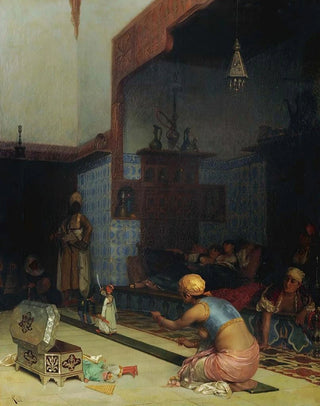Art print | Marionnettes dans le harem - Theodoros Ralli


View from behind

Frame (optional)
In the captivating world of oriental art, "Marionnettes dans le harem" by Theodoros Ralli stands out for its narrative richness and emotional depth. This artwork, which evokes the mysteries and subtleties of life in a harem, transports the viewer to a world where exoticism and sensuality meet. Through vibrant colors and meticulous details, Ralli manages to capture the essence of this often idealized reality, offering a vision that is both intimate and universal. By immersing oneself in this lively scene, the observer is invited to explore the social and cultural dynamics of the time, while being seduced by the beauty of the figures depicted.
Style and uniqueness of the work
Ralli's style is characterized by a realistic approach, but also by a touch of imagination that transcends simple representation. In "Marionnettes dans le harem," the artist uses a palette of warm, shimmering colors that evoke the heat of the oriental climate and the richness of textiles. The characters, dressed in sumptuous costumes, seem to come alive under Ralli's brush, each bearing an expression that tells a unique story. The arrangement of the figures, intertwined in a silent dance, creates an atmosphere of mystery and complicity. This artwork does not merely depict a frozen moment in time; it invites a deeper contemplation of human relationships and the emotions hidden within.
The artist and his influence
Theodoros Ralli, born in Greece, established himself as a major figure of Orientalist art in the 19th century. His artistic journey, marked by diverse influences ranging from classical tradition to the exploration of Eastern cultures, allowed him to develop a unique style that combines technical precision with aesthetic sensitivity. Ralli traveled across the Orient, immersing himself in landscapes, customs, and ways of life that he later translated into his works. His ability to capture the soul of his subjects made him a pioneer in depicting scenes of daily life in harems, a theme that continues to fascinate today. His contribution to the

Matte finish

View from behind

Frame (optional)
In the captivating world of oriental art, "Marionnettes dans le harem" by Theodoros Ralli stands out for its narrative richness and emotional depth. This artwork, which evokes the mysteries and subtleties of life in a harem, transports the viewer to a world where exoticism and sensuality meet. Through vibrant colors and meticulous details, Ralli manages to capture the essence of this often idealized reality, offering a vision that is both intimate and universal. By immersing oneself in this lively scene, the observer is invited to explore the social and cultural dynamics of the time, while being seduced by the beauty of the figures depicted.
Style and uniqueness of the work
Ralli's style is characterized by a realistic approach, but also by a touch of imagination that transcends simple representation. In "Marionnettes dans le harem," the artist uses a palette of warm, shimmering colors that evoke the heat of the oriental climate and the richness of textiles. The characters, dressed in sumptuous costumes, seem to come alive under Ralli's brush, each bearing an expression that tells a unique story. The arrangement of the figures, intertwined in a silent dance, creates an atmosphere of mystery and complicity. This artwork does not merely depict a frozen moment in time; it invites a deeper contemplation of human relationships and the emotions hidden within.
The artist and his influence
Theodoros Ralli, born in Greece, established himself as a major figure of Orientalist art in the 19th century. His artistic journey, marked by diverse influences ranging from classical tradition to the exploration of Eastern cultures, allowed him to develop a unique style that combines technical precision with aesthetic sensitivity. Ralli traveled across the Orient, immersing himself in landscapes, customs, and ways of life that he later translated into his works. His ability to capture the soul of his subjects made him a pioneer in depicting scenes of daily life in harems, a theme that continues to fascinate today. His contribution to the






